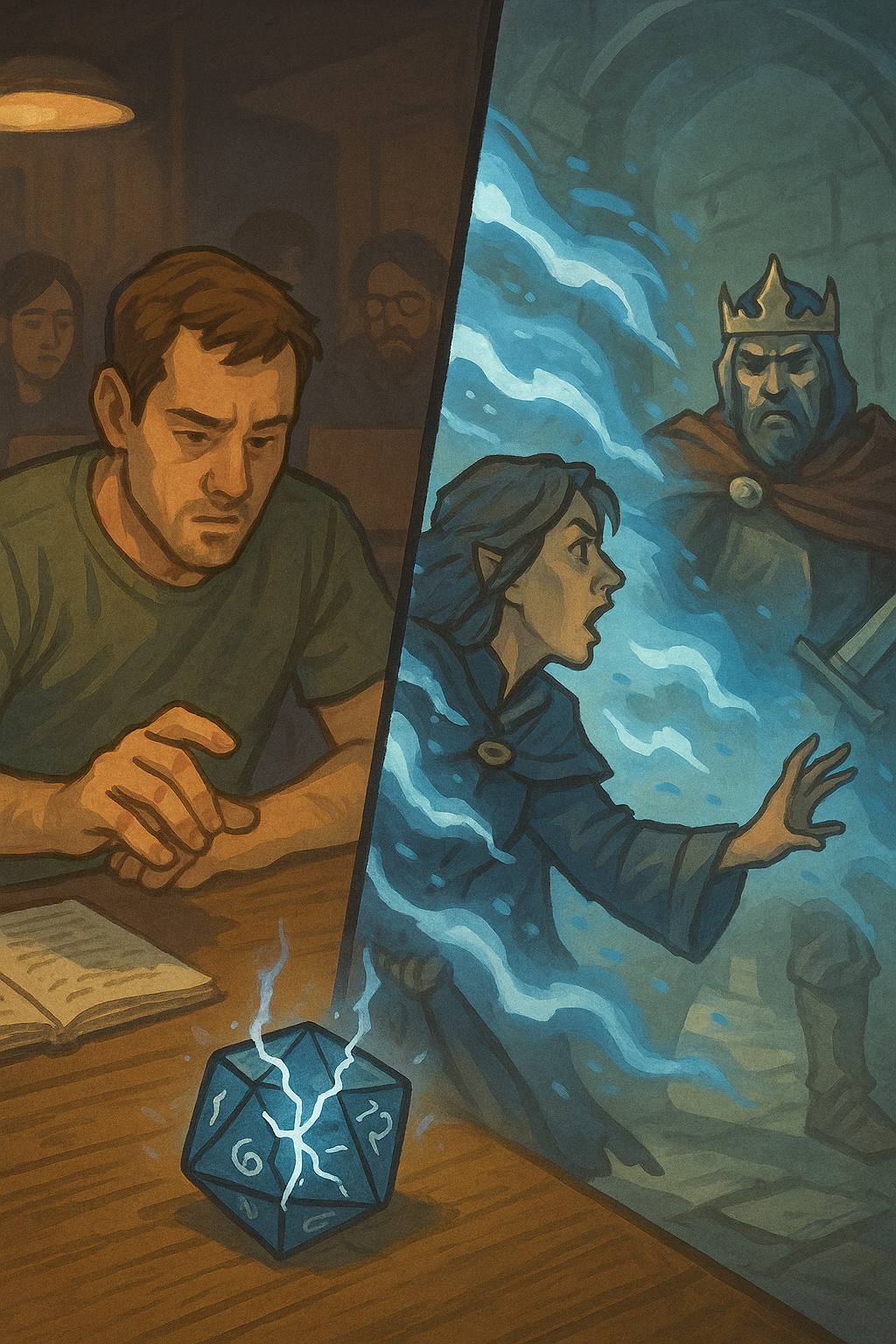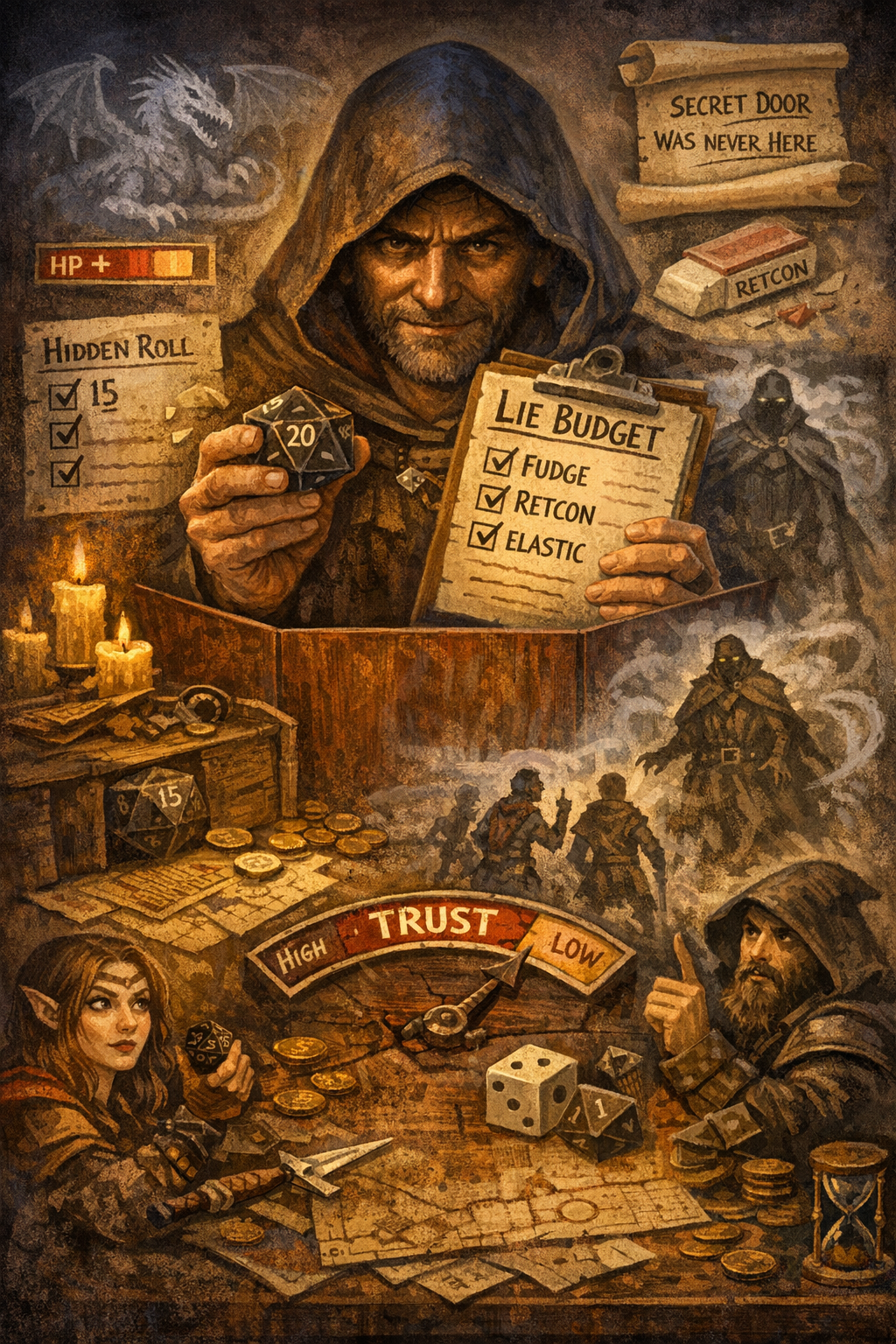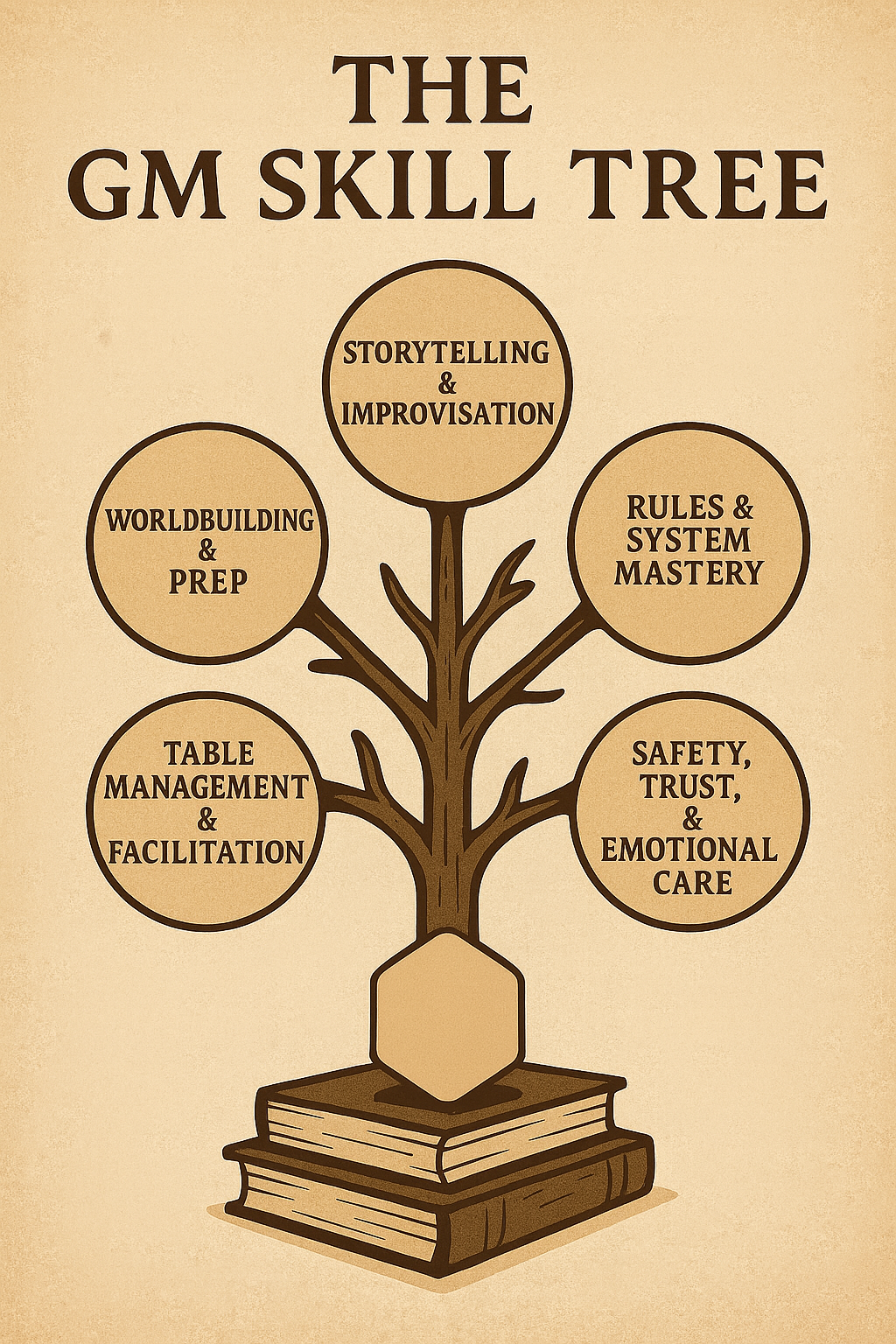When Dice Lie: Embracing Metagame “False Starts” for Dramatic Effect
The Dice Giveth, and the dice taketh away...

Dear Readers,
Have you ever watched a player’s face fall after the dice betray them yet again? That moment when a character reaches across a chasm, and what should be a heroic leap turns into a humiliating face-plant? We laugh. We groan. We move on. But what if I told you that those “natural 1s” and uncanny scoring streaks aren’t simply bad luck or pure chance—they can be powerful narrative tools? Welcome to the art of embracing metagame “false starts” for dramatic effect. In this post, we’ll explore how to use dice “lies” to enrich your story, heighten tension, and turn every roll—good or bad—into an opportunity for unforgettable storytelling.
1. The Illusion of Fate and the Truth of Story
Many players come to Dungeons & Dragons expecting a pure reflection of dice results. A high roll equals success; a low roll, utter failure. Yet seasoned GMs know that raw outcomes often hamper narrative flow. The illusion of fate— that dice are the final arbiters of success—can be subverted to enhance drama rather than stymie it. By deliberately leveraging “false starts,” you turn each roll into a storytelling pivot point.
Dice in D&D represent uncertainty, risk, and the thrill of the unknown. When you embrace the idea that dice “lie”—that their apparent verdict might not be the final word—you allow yourself to guide the story toward richer, more compelling arcs. False starts are not about cheating or railroading; they’re about balancing player agency with narrative momentum.
2. Defining Metagame “False Starts”
What exactly do we mean by a metagame “false start”? In this context, a false start occurs when players believe that a dice roll has determined the outcome, only for the narrative—or even a later mechanical revelation—to retroactively alter what they thought had happened. It’s a controlled illusion: the characters and players experience an initial success or failure, then discover layers beneath the surface that change their understanding of events.
It’s crucial that false starts remain transparent in intent: the goal is not to frustrate, but to surprise and engage. Done well, players relish the unexpected twist. Done poorly, it can feel like a cheap trick. The key is to ensure every false start enriches the story world rather than undercuts player agency.
3. Why Embrace the Lie? The Benefits of False Starts
Integrating false starts into your sessions can yield a host of narrative and mechanical benefits:
3.1 Heightening Suspense
When players learn that a triumph was illusory—or that a failure masked a hidden victory—the stakes skyrocket. Suspense arises not only from the dice but from the uncertainty of whether outcomes are what they seem. Each roll becomes a moment of dramatic tension, followed by a revelation that deepens engagement.
3.2 Deepening Character Arcs
Imagine a character who believes they betrayed a comrade because of a failed Persuasion check—only to discover they were manipulated by outside magic. That false failure can become a crucible for character growth: guilt, redemption, and resilience. False starts give players emotional hooks, fostering deeper investment in their characters’ journeys.
3.3 Reinforcing Themes and Tensions
False starts can echo the core themes of your campaign. In a horror campaign, initial successes might conceal worsening doom. In a political intrigue campaign, diplomatic victories can mask hidden betrayals. By aligning false starts with your thematic through lines, you weave a tighter narrative tapestry.
4. Mechanics vs. Narrative: Striking the Balance
Integrating false starts means occasionally overriding—or augmenting—raw dice outcomes. This requires finesse:
- Transparency: Be clear afterward about why the false start occurred (magical deception, miscommunication, secret dice modifier) so players understand it’s part of the world’s logic, not the GM railroading them.
- Fairness: False starts shouldn’t systematically punish one player or character class. Distribute them across the table to maintain fairness.
- Pacing: Use false starts sparingly. If every roll comes with a twist, the effect wears thin. Reserve them for high-stakes moments to maximize impact.
Balancing mechanics and narrative, you never want players to feel the dice don’t matter. Instead, they should feel that the dice do matter, but their meaning can be more nuanced than raw success or failure.
5. Practical Techniques for Running False Starts
Here are concrete methods to introduce false starts seamlessly into your game:
5.1 Narrative Rewinds
- Initial Outcome: GM narrates a success or failure based on the roll.
- Interruption: Shortly after, describe a sudden shift—enemy reinforcements arriving, a hidden trap triggering, or evidence that the initial outcome was compromised.
- Reveal: Clarify what caused the shift (e.g., an enemy used misdirection, an environmental hazard lurked).
- Next Roll: Allow a follow-up check with new context—often at a lower DC, representing the characters’ regained footing.
Use narrative rewind to turn apparent victories into renewed challenges, or severe failures into unexpected advantages.
5.2 Secret Meta-Modifiers
Implement hidden modifiers that remain unknown until after the roll:
- Magical Interference: An unseen auras imposes +2 or –2 to all Charisma checks.
- NPC Skill Boosts: The diplomatic envoy has Expertise in Deception, raising their contested roll.
- Environmental Factors: A sudden gust throws off an Archer’s shot by imposing disadvantage.
After a dramatic result, reveal the modifier: “You release the arrow, and it... soars straight—until a hidden ward emits a pulse, altering its path!” Players realize the initial success was overwritten by external factors.
5.3 Parallel-World Teasers
Borrow from cinematic “What If?” sequences:
- Present a brief scene: players see their characters succeed in a montage or “vision.”
- Abruptly snap back: “Then reality crashes in.”
- Offer a saving throw or Investigation check to reveal that the scene they glimpsed was a magical projection, an illusion by a rival spellcaster, or a future possibility.
This technique teases possible outcomes, creating both hope and dread when those outcomes fail to manifest.
5.4 Cliffhanger Cliff-Rolls
End a session on a dramatic dice reveal—then extend:
- Conclude with an imminent threat and a roll.
- For the first few seconds of the next session, let players revel in their success or angst over their failure.
- Use that emotional high or low to launch into the reveal: “That shield bash seemed to shatter the cultist’s blade—until you see it reform in his hand.”
Cliff-rolls create appointment dynamics between sessions, making players eager to discover what their dice actually wrought.
6. Examples in Play: Dramatic False Start Scenarios
Below are three fully fleshed examples you can adapt for your table.
6.1 The Chasm That Wasn’t
Setup: The party must leap across a deep chasm. A high Athletics check determines success.
- Roll: The player scores a 20.
- Narration: “You sprint, leap, and grasp the far ledge. You pull yourself up—solid ground beneath your feet!”
- Twist: “Suddenly, the ledge trembles. A hidden sinkhole fractures, and you slide toward the void.”
- Mechanic: Call for a DC 12 Dexterity saving throw to grab the rocky lip.
- Reveal: The ledge had been undermined by subterranean creatures. What seemed like unqualified success was the calm before the storm.
This dramatic rewind forces players to stay on their toes, and transforms a single check into a multi-stage challenge.
6.2 The Betrayed Parley
Setup: PCs negotiate a ceasefire with a rival warlord. They roll Persuasion contended by the warlord’s Deception.
- Roll: PC rolls a 17; warlord rolls a 12.
- Narration: “The warlord nods solemnly and steps forward to shake your hand.”
- Twist: “But as your hands meet, poison drips from his gauntlet—this was a feint.”
- Mechanic: Constitution saving throw or suffer poison damage.
- Reveal: The warlord never intended peace; your Persuasion simply bought you a moment of contact.
Here, an apparent victory masks malevolence, underscoring political themes and keeping negotiations fraught.
6.3 Illusory Boss Encounter
Setup: The party faces the demon lord Kor’vul. They roll to strike the final blow.
- Roll: PC lands a critical hit.
- Narration: “Your sword pierces his heart; he staggers back and collapses.”
- Twist: “The cavern walls flicker—the corpse melts into shadow, revealing a laughing imp.”
- Mechanic: Investigation check to find the real Kor’vul’s hidden chamber.
- Reveal: The demon used Project Image to fake his death, buying time for reinforcements.
False start here extends the final boss encounter, turning one climax into multiple dramatic peaks.
7. When (and How) to Avoid Overuse
False starts are powerful, but they can lose potency if you:
- Use Them Too Frequently: Every roll shouldn’t come with a hidden agenda. Reserve false starts for plot-critical moments.
- Ignore Player Expectations: Unexpected rewinds without justification breed mistrust. Always tie the twist to in-world logic.
- Punish Players: If false starts feel like punishments, morale dips. Balance with moments where an apparent failure reveals hidden success.
A good rule of thumb: if you find yourself using false starts more than once per session, step back and evaluate whether they’re enhancing or distracting from your core narrative.
8. Player Buy-In: Setting Expectations
Meta-communication is your ally. Consider discussing the concept of narrative twists and “uncertainty layers” during Session 0. Frame false starts as part of your table’s style:
“At our table, not every win or loss is what it seems—sometimes there’s more going on beneath the surface. Embrace the drama!”
This sets the tone and prevents players from feeling blindsided.
9. Integrating False Starts into Long-Term Campaigns
For campaigns that span months or years, false starts can become signature hallmarks:
- Recurring Villain Trickery: Let your arch-nemesis reveal that each apparent defeat was an illusion, ratcheting the stakes each time.
- Prophetic Visions: Give players glimpses of future victories or disasters—then twist them to keep everyone guessing.
- Evolving Environments: A fortress they stormed “successfully” last session might be revealed as a decoy or a projection in the next.
Over time, false starts reinforce your campaign’s unpredictability, ensuring veteran players never get too comfortable.
10. Conclusion: Rolling with the Illusion
Dice don’t lie—but their stories can. By embracing metagame “false starts,” you transform every roll into a dramatic pivot, heighten suspense, and deepen narrative resonance. Whether you’re running a one-off horror one-shot or a sprawling epic, strategic false starts keep players engaged, invested, and on the edge of their seats.
Remember:
- Use false starts sparingly and purposefully.
- Tie them to your campaign’s themes.
- Maintain fairness and transparency after the reveal.
- Communicate your table’s style at the outset.
So next time Lady Fortune seems to betray you with a critical failure—or smile upon you with a critical success—ask yourself: Is this the end, or merely the beginning of a grander twist? Roll on, storytellers, and let the dice lie beautifully.
Until next time, Dear Readers...






















